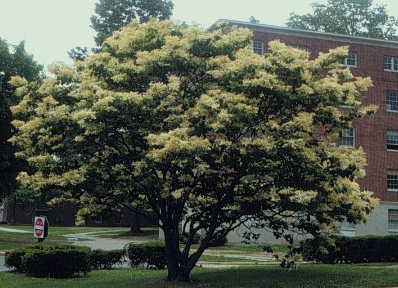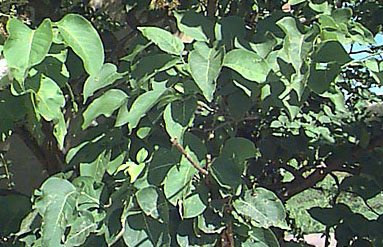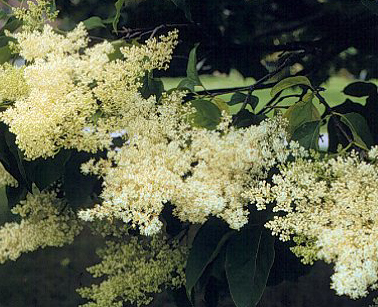David Daehnke
gardeningguru@juno.com
NJ
United States
This page has been visited times.

Syringa reticulata
Japanese Tree Lilac
Family - Oleaceae
The Japanese tree lilac is native to Northern Japan and is hardy in the United States to zone 3. I will warn those of you who live in the warmer climates that it does not do well in zones 8 or higher because it definitely likes the cooler weather. They classify this plant as a large shrub or small tree, which is the same classification as a dogwood. It has stiff, spreading branches and a nice rounded crown. Japanese tree lilacs grow only 20 to 30 feet tall and 15 to 25 feet wide, depending on the variety that is purchased (see below for a listing of cultivars). The growth rate is medium as well as the texture (appearance) of the plant. You can identify the tree lilac because of its simple, entire leaf that is oppositely arranged, and by its nice dark green leaf. Although the leaf has nice spring through summer color, the fall color is almost non-existent, quickly changing to yellow and falling in autumn.

The flowers have an off-white color, but are extremely fragrant. They are borne in panicles that almost a foot long and up to 10” wide, showy, and bloom in early June. The key is that this plant flowers profusely when established, so much so that it looks as though there are white clouds around the tree. You can leave the fruit capsules on the plant for winter interest, but I prefer to remove them after flowering so the plant does not spend that energy on seed production, but instead spends it on vegetative and root development.

As I stated earlier, the bark is very ornamental, resembling that of a cherry tree with its lenticels and glossy brown appearance. All too often we forget about winter interest from plants, but this tree will definitely have a nice appearance and interest in the winter.
Japanese tree lilacs prefer full sun and a well-drained, slightly acidic soil. It transplants easily from containers or Balled and Burlap. This plant is receiving notoriety lately as a street tree due to its ability to remain a manageable tree, dark green foliage, and profusion of flowers. It is somewhat resistant to mildew, scales and borers that normally affect regular lilacs. It can also be used for a specimen and group plantings. I prefer to use it as a small specimen tree in a location where size may be a limiting factor as to what you can or cannot plant. If you are adventurous, it can be propagated by cuttings or by seed, but if you start seeds, keep in mind the seedlings may vary from the parent stock.
Cultivars/Varieties 'Chantilly Lace' - A form with variegated foliage, the leaves of this plant feature a pale creamy yellow perimeter. It will benefit from sitting out of direct afternoon sun and good irrigation during drought. 'Cameo Jewel' is a new variegated form with yellow-cream splashed foliage.
'Ivory Silk' - This selection forms a pleasant, rounded tree to 25' tall with stocky branch structure. It is very common in commerce and blooms heavily, even as a young plant. Pests do not bother the healthy, deep green leaves and the cherry-type bark is attractive all year.
'Summer Snow' - A more compact, rounded tree, this form reaches 20' tall with ample production of very large flower panicles. Its toughness and small size may make the plant a good street tree.
If space is a concern and you are looking for a flowering tree, give Japanese tree lilac a chance. I promise you won’t be disappointed!
Dave aka The Gardening Guru